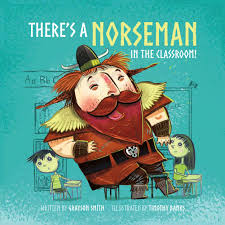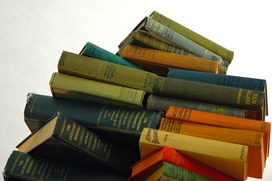 This coming September I will be changing my role from a Resource and ELL specialist teacher at the elementary level, to a high school ELL teacher. In preparation for this change I have been excited to explore new reading material that I can use in my practice. The list below was gathered from first looking into the high school version of Tribes Learning Communities, which I'm really excited to explore, and then a google search on "picture books for teenagers." In ELL it can be challenging to engage early language learning in interesting content that is at their reading level, and so I was inspired to explore how to use picture books in the ELL secondary classroom. The below books are titles I'm exited to crack the cover of and let my mind wonder to a creative place of planning for September.
0 Comments
 This school year I have had the opportunity to work collaboratively with a teacher colleague who teaches a Grade 4/5 split class. I'm always very excited to collaborate with classroom teachers when doing my Resource Teacher role. We planned to collaborate, co-plan and co-teacher some units, lessons and activities. In our early discussions I learned that this teacher was very interested in Jeanne Gibbs' Tribes Learning Communities, and because I had already done Tribes with my own class a few year earlier, I offered to support in setting them up, introducing the concept to the students, and then running some Tribes activities. Attached are a PDF and Power Point version of the basic introductory lesson I put together for the class. Now, almost at the end of the year, I have seen Tribes once again be a very supportive and highly effective teaching plan to bring into the classroom. It has been a very fun experience and I have really enjoy getting to do Tribes again. I can't recommend the concept highly enough! For other posts on Tribes go to the below listed posts: Introducing Tribes: Part I Introducing Tribes: Part II
 Over the school year I have been working in many different classrooms and with teachers who are working to implement British Columbia's New Curriculum. It has been interesting to be apart of this new change in BC's education system. The new curriculum focusses, among other parts, heavily on an inquiry model of learning. With inquiry, students are asked to think about what they know and then explore what they wonder in a range of topic areas. Inquiry is something I have observed that students do not naturally know how to do in the classroom context, when simply left to inquire on their own. Children are however naturally good at asking questions and wondering about many different things in their outside of school lives, so linking their natural skills at asking questions to the classroom context has been exciting to observe and support. A couple years ago in my classroom I always enjoyed encouraging my students to ask questions and connect with their own learning process, and so when inquiry became such a major focus to the new curriculum I started to collaborate with teachers on how to support their students in this new way of teaching. As a result, I led a few explicit lessons on what inquiry is for Grade 6/7 classes and a Grade 2/3 class. I often find that explicit instruction is what students need with complex or abstract concepts. Inquiry is a challenging process and I worked to bring in the most basic and simplistic information I could gather to explain what they would be doing. Below are the PDF and Power Point versions of both presentation lessons I put together for the Grade 6/7 and 2/3 classes.
 This month at a staff meeting our principal led a talking circle, and I wanted to share a thought I had on the topic of resiliency. We have been looking at resiliency as a theme at our school, and I find in the area of learning resource that resiliency is so important for students to develop. As I listened to our staff share I reflected on my thoughts, and knowing that I work with some of the students who experience the most amount of barriers and challenges, that their resiliency needs to be truly fostered. I wondered how I could articulate what my role in this process is? As I thought about what I wanted to say I reflected on times that I have lost sight of the path I am on and began to struggle. I have been fortunate in my life to have wonderful personal and professional support networks that help me, and I realized that I offer this to my students. As an educator I can be the calm and supportive presence that provides direction to the path of resiliency when students have lost sight of their progress. This is one of the reasons I enjoy my profession so much. When a student who has struggled finally says, “I can do this!” and truly believes they can overcome barriers, it is a gift to watch. What supports your personal resiliency and how can you bring it into the classroom? I was at the conference Working Memory, Executive Functioning & Learning Difficulties:
Linking Research and Practice put on by REACH OG Centre. I worked for REACH as an Orton-Gillingham (OG) tutor from 2007-2008 and was very excited to attend their conference. It was one of the best conference I have attended in a long time. The topic and presenters were excellent and I walked away feeling inspired and looking forward to continuing my work with students with Learning Differences. I also purchased a couple resources I wanted to share as great tools to add to the classroom or resource teacher's bookshelf. By: Gavin Reid (one of the presenters) By: Gavin Reid and Shannon Green If you are interested in learning more about the REACH conferences please visit their website here.
 Here is a really great story written by a local Delta police office! This is an engaging and creative story that captures student's compassion and speaks to them at their level. Grayson has used the stories from his wife's school to truly capture some of the challenges and ultimately wonderful lessons that come from including students with special needs in our classrooms. I have used this book this year for demystifications in my school as a way to open the conversation about our students who need that extra support and understanding from others. When I have read this book students have laughed, nodded along and felt the hurt of Norm the Norseman. The discussion that follows this story is one of openness and acceptance. Even if you don't have a student with special needs in your class it's worth reading to share the lesson of empathy! As well, $2 dollars from each book sale goes to supporting Special Olympics BC.  Here are a couple resources I have found great in the past few months and wanted to share! 1. Junior Illustrated Math Dictionary By: Kirsteen Rogers and Tori Large 2.Teacher's Resource Guide: The Staff Development Guide to the Most Common Learning and Beahviour Problems Encountered in the Education Environment By: Stephen B. McCarney and Kathy Cummins Wunderlich  Wishing everyone a Happy New Year and a wonderful start to 2016. It has been a busy fall and I have been learning so much in my role as a resource and ELL specialist teacher. To start 2016 and the second term of the school year I thought I would share some of my thoughts and wonderings for the coming new term with my students. I have been reflecting on what inspires me and what inspires my students. What motivates creativity and perseverance? How can we as educators inspire our students? Is asking the question enough? What steps can I take to support creativity and inspiration in my students? These are some of the questions I have been wondering and will be looking for the opportunity to explore over the next few months. What are your goals for the new year with your students? It has been a busy start to the school year in my new role as a Resource and ELL teacher back in Canada. I am enjoying my new role and learning a lot every day!
I wanted to share a really great site with you called ADDitudemag.com This site is for parents, educators and people with ADHD. It has great articles that are short and to the point. They have done a wonderful job of proving interesting topics, supportive and informative. I have found the site especially useful for supporting my students with a combination of ADHD and a Learning Difference. As well it has been a great resource to share with parents! |
Ms. Kolshuk's BlogWelcome to my blog where I post about my teaching practice, ideas, findings and discuss topics of an educational nature. Please feel free to comment and/or email with any topic suggestions.
Categories
All
Archives
July 2017
|
|||||||||||||||||||||||||||||||||||||||||||||

 RSS Feed
RSS Feed